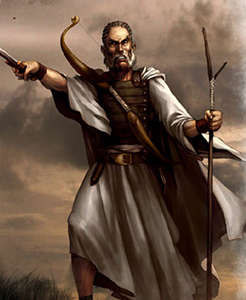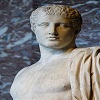Amphiaraus
oracular spirit of the Underworld
Amphiaraus - the legendary king of Argos, the seer and healer, honored as a god.
According to the mythological story Amphiaraus was the son of king Oikles (Oicles) from the line of Melampus, who was a great seer-healer. This gift was handed down from generation to generation and Amphiaraus took this disposition too. He became the king of Argos, ruling together with Adrastus, whose sister Eriphyle became his spouse too.
Polynices, the son of Oedipus, chased by his brother, visited Argos and asked for the assistance to seize Thebes. Amphiaraus did not agree to take part in the war, because he already knew, that the gods would get angry and the leaders should pay for it very badly. Polynices used a guile, he offered the famous necklace of Harmonia, Aphrodite's daughter and Thebean Cadmus' wife, to Eriphyle and with her support and initiation Amphiaraus went to besiege Thebes together with the other six leaders.
Before he left he gave the order to his sons Amphilochus and Alcmaeon to avenge his death. As he expected in the battle many leaders died and Amphiaraus turned his chariot back to Attica, trying to escape. At this moment the Theban Poriclymenus, the son of Poseidon, wanted to kill him, but Zeus threw his thunder and the earth opened to swallow Amphiaraus together with his chariot.
The story about Amphiaraus was popular during ancient times, so there are many tales about it with various details. Amphiaraus was mentioned by Homer as well as by the other ancient poets - Aristophanes, Philippides, Carcinos, Pindar and mainly Aeschylos, who was inspired by this myth in his tragedy "Seven against Thebes". Pausanias was describing the place, where the people believed, that the earth opened for Amphiarius (Amphiarios): there was a small enclosure with pillars on the right of the road from Potniai to Thebes, where no birds perched on it, no wild beast or farm animal ever grazed the grass.
The dramatic scenes from Amphiaraus' life are also depicted on some black and red figure vases, dated between 6 and 4th century BCE. In the Archaic period Amphiaraus is presented with six leaders armed for fighting. A strong composition with theme of Amphiaraus' departure is painted on the lekanis from Acropolis in Athens. Amphiaraus is sitting in his chariot, driven by a charioteer. A special gesture and the atmosphere of agreement is shown between him and his small son Alcmaeon, while Eriphyle is standing further, keeping the fatal necklace.
All leaders of the Thebean war,- included Amphiaraus swallowed into the earth- are represented on a huge volute crater (made by the Bologna Painter) in the National Archaeological Museum of Athens. Finally, the classical beauty and melancholy is depicted too on a pelike (by the Chicago Painter) in the Lecce Museum Italy with Polynices and Eriphyle, who was been bribed with the amber necklace.
The Oropians were the first to believe, Amphiaraus was a god. In Oropos (NW of Attica) was the most important center, where people were worshipping Amphiaraus, but it was also as a healing and fortunetelling place. The ruins of the temple, which was built probably on the older shrine, are dated back to the 4th century BCE. In the middle part was the cult statue of Amphiaraus in white marble, and his features appeared much like the god Asclepius.
The cult ritual is known from the inscriptions, found in the Amphiareion, from the work of ancient authors and also from some votive reliefs. Everyone who came to consult Amphiaraus had to purify himself by offering something to Amphiaraus and to the other gods and heroes. He had throw gold and silver coins in the Sacred Spring and put various objects like small statues, marble reliefs or votive human limbs on the altar in front of the temple.
After sacrificing a ram, one had to wrap himself into the fresh skin of this animal and sleep with it inside the Stoa (Enkoimeterion = "place to sleep inside"). During his dream he received the advise of the god for his problem or the way how to be cured.
The signs, coming from the gods and giving direction to a man were long time established in the Greek culture. All Greek gods dispensed the signs, but most of them Zeus, who was responsible for the dreams, while Apollo knew the art of interpreting them. The seer (mantis) was a high specialist for discovering the advice from the god and its interpretation. Amphiaraus particularly absorbed both of these roles as arbiter of the dreams and the adviser, mainly for health and cure of sick people. He was the seer and healer, deified and worshipped as a god.
[1]












